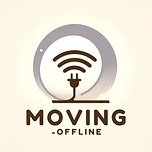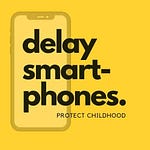Two ways to support Moving Offline:
Chris emailed me last week to schedule a chat with me. He wasn’t looking for another productivity hack or the latest app to "fix" his digital habits. He wanted to gain insight. We chatted for over an hour and a half. At first, it was about screen time. Notifications, social media, the pull of endless digital distractions. But as we talked, he came to realize what many of us in the path know: We don’t fix digital overwhelm by tweaking settings. We don’t escape hyper-connectivity with a handful of hacks. Digital Minimalism isn’t primarily about technology.
It’s about our mindset.
The way we think about technology. The choices we make, the habits we form. Those define whether digital minimalism becomes a fleeting experiment or a lifelong shift. So today, we’re not talking about which apps to delete or how to optimize screen time. We’re exploring the four fundamental mindset shifts that help us thrive in the offline world.
Because moving offline isn’t just about stepping away from screens. It’s about stepping into a life you love.

Clarity
Whether we realize it or not, the online world has become a space of emotional refuge. A place that seems to offer everything we seek. Answers to every question, instant connection to loved ones, or an endless stream of entertainment ready to fill any quiet moment. And yet, at the same time, it gives us nothing.
We turn to the internet instinctively. We scroll when we’re anxious, tap when we’re restless, refresh when we’re uncertain. When I moved to Albany, GA after completing my graduate program, I leaned on the web as a lifeline to familiarity. My social circle at university had dissolved overnight, and I used the powers of the WiFi router to keep those friendships alive, to recreate the conversations and camaraderie I had left behind. Their presence, though virtual, eased my loneliness for a while.
But when the screen turned off and the goodbyes were exchanged, the silence returned. The sadness crept back in, waiting for me where I had left it. I didn’t deal with those emotions during that first year away from school. I masked them beneath a flickering screen, distracted myself with amusements and digital consumption. And suddenly, I found myself spending 12 to 13 hours a day in front of the screen, caught in a cycle of escapism.
So, before we can move offline, we must ask ourselves a difficult question: What is the internet fulfilling for us? It’s tempting to think of our devices as neutral tools. Simple conveniences in the modern world. But behind every swipe, every click, every search, there’s a deeper pull. A need being met. A void being filled. A distraction carefully placed between ourselves and something we are unwilling to face.
Moving offline is uncomfortable. But in that discomfort, there is space. Space to take a walk, to color, to journal, to sit with your thoughts. And in that space, you gain clarity. You begin to see the role your devices play in shaping your emotions. And with that comes a realization: Are you using your technology, or is it using you?

Curiosity
Once clarity sets in, curiosity comes next. The silence left by the absence of screens isn’t emptiness—it’s possibility. My first year into digital minimalism was deeply boring. I focused on deprivation. I constantly told myself what I shouldn’t do. No desktop, no YouTube, no mindless scrolling. But I never asked the more important questions: What should I do instead? Which activities would fill the void? Where can I find community?
Curiosity is what shifts digital minimalism from restriction to exploration. It nudges us toward action, toward new experiences, toward the simple act of wondering what’s possible beyond the screen. Recently, I’ve made strides in this area. I joined a local cycling club, started attending Saturday night outings, and experimented with new protein bar recipes.1 The act of asking and exploring leads to new discoveries, and the offline world proves, again and again, that there’s always more to uncover.
Adopting and understanding this mindset shift is essential to the journey. It challenges you to say yes. Some starter pack curiosity questions that will enter your vernacular will be: What else is out there? What can I build, create, experience? Who can I meet, reconnect with, or learn from?
Curiosity is the transition from passive consumption to active involvement. It’s the difference between watching Instagram reels and creating moments worth living for.

Choice
And thus, we arrive at choice. The defining point in digital minimalism where intention takes shape. This is where we decide when we engage with technology, which days we step away, and how we build a healthier relationship with our devices.
It’s the conversation with your employer, setting boundaries around after-hours Slack messages because you’ve switched to a dumbphone. It’s asking the server for a paper menu instead of scanning a QR code. It’s choosing how engaged, or disengaged, you want to be with technology. Do you limit screens in the morning to start the day with reflection time? Do you designate one evening a week for offline experiences? Do you create tech-free zones in your home? These decisions shape your habits. They shape how you experience time, focus, and connection.
Chris asked me about this part during our conversation. How do I negotiate with my boss? How do I not make my family angry because I’m not part of the group chat? How do I not become a nuisance to the world around me? This is why the first two mindset shifts matter. You can’t make a meaningful choice without first understanding what is important to you.
Without clarity, boundaries feel like walls. Without curiosity, the world beyond screens seems empty. But once you’ve gone through both, choice stops feeling like restriction and starts feeling like alignment. A way to shape your life around what you actually value.
So, how do we navigate these challenges? At work, it may come down to a tough decision. If your time and attention aren’t respected, is staying in that environment truly worth it? Maybe it is, maybe not. Sometimes the best move is finding an employer who aligns with your priorities. With loved ones, reassurance is key. A family vacation, a thoughtful phone call, or simply making the effort to be present can accomplish the same goal as staying in a group chat.
Choice, in the context of digital minimalism, allows you to define what is important and to what degree you’ll engage with the online world. Whether it’s setting limits with a restricted smartphone or going all in with a simple Nokia, the decision is yours.

Contentment
The final mindset shift is contentment. Once you gain clarity, embrace curiosity, and exercise choice, digital minimalism stops feeling like a challenge and starts becoming a natural way to live. It shifts from focusing on what you’re removing to embracing what you’re choosing to welcome into your life.
I have friends who swear by their smart LED lights. They love adjusting the ambiance with a tap on their phone. I see the appeal, but for me, needing an app to control my lights is a deal-breaker. I’d rather stick with the simplicity of a standard bulb than add another app to my life. And I’m okay with that. I don’t feel like I’m missing out. Because I know what matters to me.
That’s the essence of contentment. It’s being at peace with your choices, free from the anxiety of what others are doing, what they have, or how they live. It’s knowing that you don’t need to impress anyone, and that you’re not defined by the latest technology or trends. This is the place of enough. Getting there takes time, and society doesn’t make it easy. We’re constantly surrounded by noise, by messages telling us we need more, better, faster. But when you step back, when you have clarity, curiosity, choice, and contentment by your side, the pull of endless upgrades fades. What remains is a life that feels whole, shaped by intention rather than impulse.
It’s the knowledge that you could have more, but you are happy with what you have.
Side tangent for those of you reading. Protein bars/Granola bars are crazy overpriced in my opinion and if you go to the gym, I highly recommend you take a look into simple no bake recipes like this one: https://cookieandkate.com/best-granola-bars-recipe/











Share this post